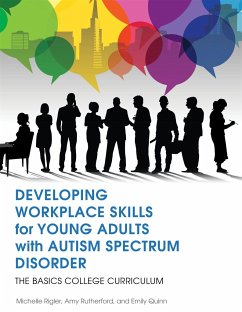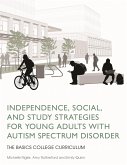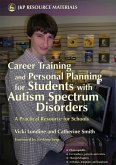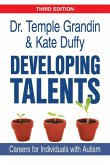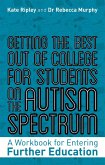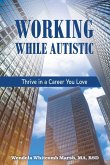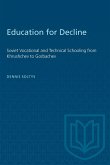Michelle Rigler, Amy Rutherford, Emily Quinn
Developing Workplace Skills for Young Adults with Autism Spectrum Disorder
The Basics College Curriculum
Michelle Rigler, Amy Rutherford, Emily Quinn
Developing Workplace Skills for Young Adults with Autism Spectrum Disorder
The Basics College Curriculum
- Broschiertes Buch
- Merkliste
- Auf die Merkliste
- Bewerten Bewerten
- Teilen
- Produkt teilen
- Produkterinnerung
- Produkterinnerung
This practical college curriculum helps students with Autism Spectrum Disorder (ASD) to enter into working life with confidence. Suitable for independent or guided study, it teaches young people strategies for managing the stresses and challenges of employment.
Andere Kunden interessierten sich auch für
![Independence, Social, and Study Strategies for Young Adults with Autism Spectrum Disorder Independence, Social, and Study Strategies for Young Adults with Autism Spectrum Disorder]() Amy RutherfordIndependence, Social, and Study Strategies for Young Adults with Autism Spectrum Disorder47,99 €
Amy RutherfordIndependence, Social, and Study Strategies for Young Adults with Autism Spectrum Disorder47,99 €![Career Training and Personal Planning for Students with Autism Spectrum Disorders Career Training and Personal Planning for Students with Autism Spectrum Disorders]() Vicki LundineCareer Training and Personal Planning for Students with Autism Spectrum Disorders64,99 €
Vicki LundineCareer Training and Personal Planning for Students with Autism Spectrum Disorders64,99 €![Developing Talents Developing Talents]() Temple GrandinDeveloping Talents31,99 €
Temple GrandinDeveloping Talents31,99 €![Getting the Best Out of College for Students on the Autism Spectrum Getting the Best Out of College for Students on the Autism Spectrum]() Kate RipleyGetting the Best Out of College for Students on the Autism Spectrum28,99 €
Kate RipleyGetting the Best Out of College for Students on the Autism Spectrum28,99 €![Working While Autistic Working While Autistic]() Wendela Whitcomb MarshWorking While Autistic26,99 €
Wendela Whitcomb MarshWorking While Autistic26,99 €![Education for Decline Education for Decline]() Dennis SoltysEducation for Decline36,99 €
Dennis SoltysEducation for Decline36,99 €![African American Students' Career and College Readiness African American Students' Career and College Readiness]() African American Students' Career and College Readiness134,99 €
African American Students' Career and College Readiness134,99 €-
-
-
This practical college curriculum helps students with Autism Spectrum Disorder (ASD) to enter into working life with confidence. Suitable for independent or guided study, it teaches young people strategies for managing the stresses and challenges of employment.
Produktdetails
- Produktdetails
- The BASICS College Curriculum
- Verlag: Jessica Kingsley Publishers
- Seitenzahl: 224
- Erscheinungstermin: 21. Juli 2016
- Englisch
- Abmessung: 277mm x 216mm x 13mm
- Gewicht: 634g
- ISBN-13: 9781849057998
- ISBN-10: 1849057990
- Artikelnr.: 42786205
- Herstellerkennzeichnung
- Libri GmbH
- Europaallee 1
- 36244 Bad Hersfeld
- gpsr@libri.de
- The BASICS College Curriculum
- Verlag: Jessica Kingsley Publishers
- Seitenzahl: 224
- Erscheinungstermin: 21. Juli 2016
- Englisch
- Abmessung: 277mm x 216mm x 13mm
- Gewicht: 634g
- ISBN-13: 9781849057998
- ISBN-10: 1849057990
- Artikelnr.: 42786205
- Herstellerkennzeichnung
- Libri GmbH
- Europaallee 1
- 36244 Bad Hersfeld
- gpsr@libri.de
Michelle Rigler, Amy Rutherford and Emily Quinn
Introduction. 1. Finding your professional niche. Lesson 1: Neurodiversity
in the workplace. Lesson 2: Finding a company that works for you. Lesson 3:
Creating your optimal work environment. Lesson 4: Professional tool for
professional niche development. 2. The interview. Lesson 1: Preparation.
Lesson 2: Making the connection. Lesson 3: Follow up. Lesson 4:
Professional tool for scripting common interview responses. 3. Disclosure
and self-advocacy. Lesson 1: Legal protection and accommodations. Lesson 2:
Art of disclosure. Lesson 3: Tell your own story. Lesson 4: Professional
tool for navigating disclosure. 4. Professional workplace structure. Lesson
1: Understanding professional communication. Lesson 2: Communication
strategies. Lesson 3: Navigating professional miscues. Lesson 4:
Professional tool for managing workplace communication. 5. Stress
management. Lesson 1: Understanding responsibilities and identifying
stressors. Lesson 2: Managing your environment. Lesson 3: Responding to
stress in the workplace. Lesson 4: Professional tool for managing stress.
6. Collaboration and teamwork. Lesson 1: The purpose of teamwork. Lesson 2:
Individual contributions. Lesson 3: Conflict resolution. Lesson 4:
Professional tool for defining your role on a team. 7. Water cooler
culture. Lesson 1: The hidden rules. Lesson 2: Learning through casual
interactions. Lesson 3: Joining the culture. Lesson 4: Professional tool
for creating social rules. 8. Career progression. Lesson 1: Starting over
is okay. Lesson 2: Ongoing professional development. Lesson 3: Evaluation
and feedback. Lesson 4: Professional tool for professional development. 9.
Next steps. Appendix A: Back to BASICS chart/professional example. Appendix
B: Guided discussion. Appendix C: Resume tools. Appendix D: Sample
interview questions. Bibliography.
in the workplace. Lesson 2: Finding a company that works for you. Lesson 3:
Creating your optimal work environment. Lesson 4: Professional tool for
professional niche development. 2. The interview. Lesson 1: Preparation.
Lesson 2: Making the connection. Lesson 3: Follow up. Lesson 4:
Professional tool for scripting common interview responses. 3. Disclosure
and self-advocacy. Lesson 1: Legal protection and accommodations. Lesson 2:
Art of disclosure. Lesson 3: Tell your own story. Lesson 4: Professional
tool for navigating disclosure. 4. Professional workplace structure. Lesson
1: Understanding professional communication. Lesson 2: Communication
strategies. Lesson 3: Navigating professional miscues. Lesson 4:
Professional tool for managing workplace communication. 5. Stress
management. Lesson 1: Understanding responsibilities and identifying
stressors. Lesson 2: Managing your environment. Lesson 3: Responding to
stress in the workplace. Lesson 4: Professional tool for managing stress.
6. Collaboration and teamwork. Lesson 1: The purpose of teamwork. Lesson 2:
Individual contributions. Lesson 3: Conflict resolution. Lesson 4:
Professional tool for defining your role on a team. 7. Water cooler
culture. Lesson 1: The hidden rules. Lesson 2: Learning through casual
interactions. Lesson 3: Joining the culture. Lesson 4: Professional tool
for creating social rules. 8. Career progression. Lesson 1: Starting over
is okay. Lesson 2: Ongoing professional development. Lesson 3: Evaluation
and feedback. Lesson 4: Professional tool for professional development. 9.
Next steps. Appendix A: Back to BASICS chart/professional example. Appendix
B: Guided discussion. Appendix C: Resume tools. Appendix D: Sample
interview questions. Bibliography.
Introduction. 1. Finding your professional niche. Lesson 1: Neurodiversity
in the workplace. Lesson 2: Finding a company that works for you. Lesson 3:
Creating your optimal work environment. Lesson 4: Professional tool for
professional niche development. 2. The interview. Lesson 1: Preparation.
Lesson 2: Making the connection. Lesson 3: Follow up. Lesson 4:
Professional tool for scripting common interview responses. 3. Disclosure
and self-advocacy. Lesson 1: Legal protection and accommodations. Lesson 2:
Art of disclosure. Lesson 3: Tell your own story. Lesson 4: Professional
tool for navigating disclosure. 4. Professional workplace structure. Lesson
1: Understanding professional communication. Lesson 2: Communication
strategies. Lesson 3: Navigating professional miscues. Lesson 4:
Professional tool for managing workplace communication. 5. Stress
management. Lesson 1: Understanding responsibilities and identifying
stressors. Lesson 2: Managing your environment. Lesson 3: Responding to
stress in the workplace. Lesson 4: Professional tool for managing stress.
6. Collaboration and teamwork. Lesson 1: The purpose of teamwork. Lesson 2:
Individual contributions. Lesson 3: Conflict resolution. Lesson 4:
Professional tool for defining your role on a team. 7. Water cooler
culture. Lesson 1: The hidden rules. Lesson 2: Learning through casual
interactions. Lesson 3: Joining the culture. Lesson 4: Professional tool
for creating social rules. 8. Career progression. Lesson 1: Starting over
is okay. Lesson 2: Ongoing professional development. Lesson 3: Evaluation
and feedback. Lesson 4: Professional tool for professional development. 9.
Next steps. Appendix A: Back to BASICS chart/professional example. Appendix
B: Guided discussion. Appendix C: Resume tools. Appendix D: Sample
interview questions. Bibliography.
in the workplace. Lesson 2: Finding a company that works for you. Lesson 3:
Creating your optimal work environment. Lesson 4: Professional tool for
professional niche development. 2. The interview. Lesson 1: Preparation.
Lesson 2: Making the connection. Lesson 3: Follow up. Lesson 4:
Professional tool for scripting common interview responses. 3. Disclosure
and self-advocacy. Lesson 1: Legal protection and accommodations. Lesson 2:
Art of disclosure. Lesson 3: Tell your own story. Lesson 4: Professional
tool for navigating disclosure. 4. Professional workplace structure. Lesson
1: Understanding professional communication. Lesson 2: Communication
strategies. Lesson 3: Navigating professional miscues. Lesson 4:
Professional tool for managing workplace communication. 5. Stress
management. Lesson 1: Understanding responsibilities and identifying
stressors. Lesson 2: Managing your environment. Lesson 3: Responding to
stress in the workplace. Lesson 4: Professional tool for managing stress.
6. Collaboration and teamwork. Lesson 1: The purpose of teamwork. Lesson 2:
Individual contributions. Lesson 3: Conflict resolution. Lesson 4:
Professional tool for defining your role on a team. 7. Water cooler
culture. Lesson 1: The hidden rules. Lesson 2: Learning through casual
interactions. Lesson 3: Joining the culture. Lesson 4: Professional tool
for creating social rules. 8. Career progression. Lesson 1: Starting over
is okay. Lesson 2: Ongoing professional development. Lesson 3: Evaluation
and feedback. Lesson 4: Professional tool for professional development. 9.
Next steps. Appendix A: Back to BASICS chart/professional example. Appendix
B: Guided discussion. Appendix C: Resume tools. Appendix D: Sample
interview questions. Bibliography.

